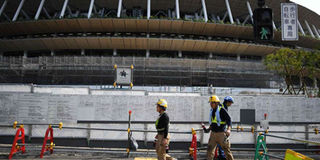Olympic flame to burn away from stadium in Tokyo city

Workers walk in front of the new National Olympic Stadium, still under construction, in Tokyo on July 24, 2019, one year before the start of the Tokyo 2020 Olympic Games. PHOTO | CHARLY TRIBALLEAU |
What you need to know:
- The start of the Olympic Torch Relay in Japan will be at the Fukushima Prefecture (province) which was seriously hit by the 2011 Fukushima Daiichi nuclear power plant disaster.
In a departure from tradition, the Olympic cauldron at next year’s Tokyo Games will be lit outside the precincts of the Olympic Stadium. In fact right in Tokyo’s city centre.
According to Tokyo 2020 Spokesman Masa Takaya and Sporting Director Koji Murofishi, the start of the Olympic Torch Relay in Japan will be at the Fukushima Prefecture (province) which was seriously hit by the 2011 Fukushima Daiichi nuclear power plant disaster.
Fukushima was also struck by a major earthquake in 2016 and the Tokyo 2020 team want to use the Games to console locals in the troubled region.
The torch will, as per tradition, be lit in Greece, the birthplace of the Olympics, on March 12 with the Japan leg starting on March 26.
The Olympic flame is expected to be lit at the "Yume-no-Ohashi" pedestrian bridge in the waterfront areas of Odaiba and Ariake.
“Many people were affected by the 2011 tragedy and after that, the sports community has enhanced the role of sport in uplifting society,” Murofushi, the 2004 Olympic hammer throw champion, now a sports scientist, told Nation Sport in Tokyo recently.
“Many never expected sports would do something to uplift these people, because many were suffering mentally and it would take really long to recover.
“But since athletes started holding events in these regions, then people started realizing that the locals wanted athletes to come to them, and this showed what sport can do.
“Tokyo 2020 is a vivid demonstration of the power and values of sport.”
HYDROGEN AS FUEL
According to the Kyodo News Agency, the Olympic cauldron “will be designed as a sphere using the sun as a motif.”
“Proposals have also been made to use hydrogen as fuel to keep the fire in the cauldron burning, to promote Japan's next-generation energy initiatives to the world,” the agency quoted sources as saying. Traditionally, the Olympic Torch Relay begins with the kindling of the Olympic flame by the rays of the sun in Olympia, Greece, and is followed by a relay around Greece.
The Olympic flame is then transported to the host country where a Torch Relay is conducted until the Opening Ceremony of the Games.
The Olympic flame is a globally-recognised symbol of the Olympics, and the parading of the flame represents the Olympic ideals of peace, unity and friendship.
Through the Torch Relay the Olympic values are disseminated across the entire host country, and the relay serves to raise interest in and expectations for the Games.
Actually, there was no Olympic flame at the modern Olympics until the Amsterdam 1928 Games, when a cauldron was erected outside the main stadium.
A proposal was made to continue this practice, which has continued until the present day.
DISPLAY LATEST TECHNOLOGY
The lighting of the Olympic flame is held several months before the beginning of the Olympics at the sacred site of ancient Olympia, near the temple of Hera.
Hundreds of people then take their turn to carry the torch a short distance until it reaches the main site of the Games on the day of the Opening Ceremony.
The final runners carry the torch into the stadium and the Olympic cauldron is then lit. The cauldron stays alight until the conclusion of the Games.
Meanwhile, several Japanese companies will display latest technology in the coverage of the July 24 to August 9 Olympics and August 25 to September 6 Paralympic Games.
“Alibaba are keen on introducing technology in providing video footage to all broadcasters, while NHK will employ high definition systems for public viewing sites, providing the highest possible definition — almost like 3D,” Takaya revealed.
Reporting with additional resources from Tokyo 2020





